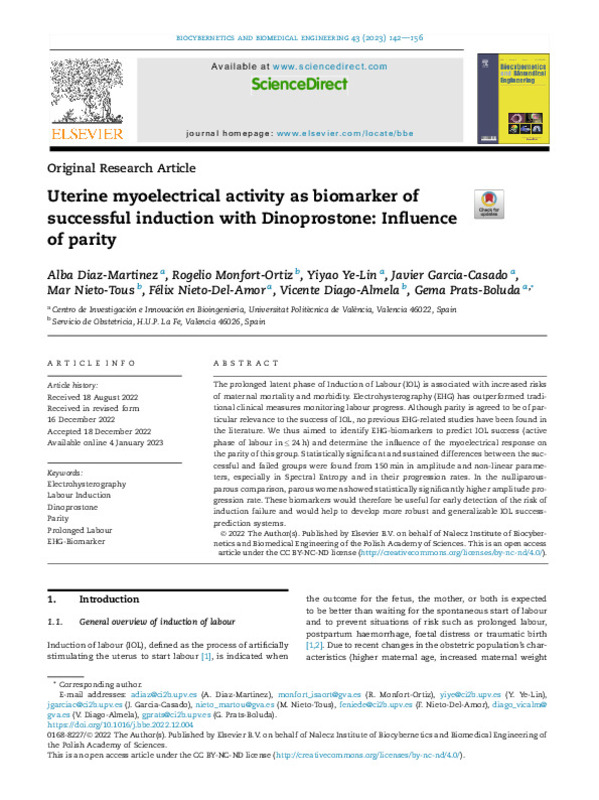JavaScript is disabled for your browser. Some features of this site may not work without it.
Buscar en RiuNet
Listar
Mi cuenta
Estadísticas
Ayuda RiuNet
Admin. UPV
Uterine myoelectrical activity as biomarker of successful induction with Dinoprostone: Influence of parity
Mostrar el registro sencillo del ítem
Ficheros en el ítem
| dc.contributor.author | Diaz-Martinez, Alba
|
es_ES |
| dc.contributor.author | Monfort-Ortiz, Rogelio
|
es_ES |
| dc.contributor.author | Ye Lin, Yiyao
|
es_ES |
| dc.contributor.author | Garcia-Casado, Javier
|
es_ES |
| dc.contributor.author | Nieto-Tous, Mar
|
es_ES |
| dc.contributor.author | Nieto del-Amor, Félix
|
es_ES |
| dc.contributor.author | Diago-Almela, Vicente Jose
|
es_ES |
| dc.contributor.author | Prats-Boluda, Gema
|
es_ES |
| dc.date.accessioned | 2023-01-19T19:01:02Z | |
| dc.date.available | 2023-01-19T19:01:02Z | |
| dc.date.issued | 2023-03 | es_ES |
| dc.identifier.uri | http://hdl.handle.net/10251/191404 | |
| dc.description.abstract | [EN] The prolonged latent phase of Induction of Labour (IOL) is associated with increased risks of maternal mortality and morbidity. Electrohysterography (EHG) has outperformed traditional clinical measures monitoring labour progress. Although parity is agreed to be of particular relevance to the success of IOL, no previous EHG¿related studies have been found in the literature. We thus aimed to identify EHG¿biomarkers to predict IOL success (active phase of labour in¿¿¿24¿h) and determine the influence of the myoelectrical response on the parity of this group. Statistically significant and sustained differences between the successful and failed groups were found from 150¿min in amplitude and non¿linear parameters, especially in Spectral Entropy and in their progression rates. In the nulliparous¿parous comparison, parous women showed statistically significantly higher amplitude progression rate. These biomarkers would therefore be useful for early detection of the risk of induction failure and would help to develop more robust and generalizable IOL success¿prediction systems. | es_ES |
| dc.description.sponsorship | This work was supported by the Spanish Ministry of Economy and Competitiveness and the European Regional Development Fund (MCIU/AEI/FEDER, UE RTI2018-094449-A-I00-AR and PID2021-124038OB-I00). Funding for open access charge: CRUE-Universitat Politècnica de València | es_ES |
| dc.language | Inglés | es_ES |
| dc.publisher | Elsevier | es_ES |
| dc.relation.ispartof | Biocybernetics and Biomedical Engineering (Online) | es_ES |
| dc.rights | Reconocimiento - No comercial - Sin obra derivada (by-nc-nd) | es_ES |
| dc.subject | Electrohysterography | es_ES |
| dc.subject | Labour Induction | es_ES |
| dc.subject | Dinoprostone | es_ES |
| dc.subject | Parity | es_ES |
| dc.subject | Prolonged Labour | es_ES |
| dc.subject | EHG-Biomarker | es_ES |
| dc.subject.classification | TECNOLOGIA ELECTRONICA | es_ES |
| dc.title | Uterine myoelectrical activity as biomarker of successful induction with Dinoprostone: Influence of parity | es_ES |
| dc.type | Artículo | es_ES |
| dc.identifier.doi | 10.1016/j.bbe.2022.12.004 | es_ES |
| dc.relation.projectID | info:eu-repo/grantAgreement/AEI/Plan Estatal de Investigación Científica y Técnica y de Innovación 2017-2020/RTI2018-094449-A-I00/ES/ELECTROHISTEROGRAFIA PARA LA MEJORA EN LA TOMA DE DECISIONES EN SITUACIONES DE RIESGO EN OBSTETRICIA: PARTO PREMATURO E INDUCCION DEL PARTO/ | es_ES |
| dc.relation.projectID | info:eu-repo/grantAgreement/AEI//PID2021-124038OB-I00//INTELIGENCIA ARTIFICIAL PARA LA AYUDA AL DIAGNÓSTICO EN TIEMPO REAL DEL PARTO PREMATURO BASADO EN LA ACTIVIDAD MIOELÉCTRICA UTERINA. ÉNFASIS EN GESTACIONES MÚLTIPLES/ | es_ES |
| dc.rights.accessRights | Abierto | es_ES |
| dc.contributor.affiliation | Universitat Politècnica de València. Escuela Técnica Superior de Ingenieros Industriales - Escola Tècnica Superior d'Enginyers Industrials | es_ES |
| dc.contributor.affiliation | Universitat Politècnica de València. Escuela Técnica Superior de Ingeniería del Diseño - Escola Tècnica Superior d'Enginyeria del Disseny | es_ES |
| dc.description.bibliographicCitation | Diaz-Martinez, A.; Monfort-Ortiz, R.; Ye Lin, Y.; Garcia-Casado, J.; Nieto-Tous, M.; Nieto Del-Amor, F.; Diago-Almela, VJ.... (2023). Uterine myoelectrical activity as biomarker of successful induction with Dinoprostone: Influence of parity. Biocybernetics and Biomedical Engineering (Online). 43(1):142-156. https://doi.org/10.1016/j.bbe.2022.12.004 | es_ES |
| dc.description.accrualMethod | S | es_ES |
| dc.relation.publisherversion | https://doi.org/10.1016/j.bbe.2022.12.004 | es_ES |
| dc.description.upvformatpinicio | 142 | es_ES |
| dc.description.upvformatpfin | 156 | es_ES |
| dc.type.version | info:eu-repo/semantics/publishedVersion | es_ES |
| dc.description.volume | 43 | es_ES |
| dc.description.issue | 1 | es_ES |
| dc.identifier.eissn | 2391-467X | es_ES |
| dc.relation.pasarela | S\480685 | es_ES |
| dc.contributor.funder | AGENCIA ESTATAL DE INVESTIGACION | es_ES |
| dc.contributor.funder | Universitat Politècnica de València | es_ES |








